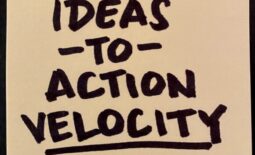10 Personal Writing Tips
One of my networking groups recently asked its members to share their best writing tips based on their personal experience, habits, and daily practice. I really love this idea because it wasn’t “best writing tips” it was “best PERSONAL writing tips” — waaaay more practical and waaay more original. You can’t just write the best advice you Googled online, you needed to share tips that you personally used and found helpful and effective in producing your writing no matter what you specialized in writing.)
Here is my list of 10 personal writing tips
 1. Write down every idea
1. Write down every idea
Even if it might suck, even if it’s not fully formed. Every. Single. Idea. I can’t tell you how many times I’ve tried to search back in my memory to some inkling I had a month, a week, or an hour and can’t come up with it. If you don’t write them down, they will be lost forever. Open and save the idea in a Word doc, write it in a fancy Moleskine, or simply scribble them on sticky notes — but get them written down.
2. Make your ideas searchable
I love Moleskines and yellow sticky notes, but they are tough to search when you’re trying to find the “one” idea you wanted to explore. I find it’s best to write in electronic format in searchable documents (I typically use Google Docs, but I’m experimenting with a couple writing apps). Sometimes the piece I’m looking for only comes to mind with a phrase or line I used (and not the title), so it makes searching easier (technically, it makes FINDING easier!) (BTW: I just scribbled that down as an idea: “Why do they call them ‘search’ engines — they should be ‘find’ engines!”)
3. Character backstories
When writing fiction, I enjoy crafting a brief “history” or biography of the character. First, it’s a fun warm-up writing exercise and second, it gives me something to go back to if I write myself into an unexpected corner. The character itself will give me a clue where to go next based on its “history”.
4. Write to where you want to end up
If I get stuck in a sequence, I jump to the end and the destination where I wanted to arrive and work backward. I’m usually good for a strong opening, but when I hit the middle and I’m beyond the fun starting point and too far away from the end I envisioned, I lose focus and get bored. My trick has been to hang on to the beginning as long as possible and only let go when I’m latched on to the ending. I dislike the middle, so I just cut it out. I’m either on the starting half of the project or the ending half of the project. 😉
5. Images inspiration
Recently, when I am need of writing inspiration or a random writing exercise (for something like 280daily.com, etc.) I visit stock photo sites and grab a random photo to use as a story spark. I just write something about whatever is featured in the photo. Usually about what happened immediately before or after the image was captured, sometimes an imaginary history of an item or fictional biography of a person featured in the photo. It’s fun, low stress, and super fun. You never know what stories the image may inspire.
6. Musical control
I’ve always been able to channel creative energy by using music. If I need to write something funny, I listen to lively fun music. If I need to write something dark and brooding, I play the appropriate audio. Might be children’s nursery rhymes, might be classical, might be jazz, might be movie soundtracks, might be Broadway musicals… ya never know! I’ve even created playlists on Spotify for certain moods or tasks. I have one dedicated to songs with the word “coffee” in them for my Beanstorming sessions, and created a list of dog-themed songs when I was preparing for my workshops with DogWatch Hidden Fence company.
7. If you get stuck, put it in reverse.
If I run into a wall with a situation or storyline or business article, I start writing down the exact opposite of what is possible in the situation. I’ll write the reverse outcome of what I want to happen, or the very worst case scenario of what happens next. I may get completely ridiculous with an alien armada coming to the rescue of a character, or a fairytale wizard waving a wand to fix everything, or maybe even the main character dying. The trick is not to stop when you put it into reverse gear, but to throw it back into drive and rock it forward so you can rock on. For instance, if I throw it into reverse and say the main character dies, the story doesn’t stop there. I slam it back into forward drive and see it through to the next step: perhaps a mentor steps out of the past to pick up where his student left off, a comrade rises up to carry the flag, or a spouse steps in and picks up the pieces of her mate’s situation. See? Plenty of ideas for even a fictional example scenario!
8. Change the setting (and your setting)
This suggestion is both for the setting in your writing and the physical environment in which you are writing. If you’re at a desk in an office, move to a coffee shop. If you’re at a coffee shop, go sit on your living room couch. Try libraries, bars, parks, and more. I personally find it helpful to write in hotel lobbies. There are constant streams of interesting people filing in and out (and if you eavesdrop you can hear some pretty interesting requests!) Many of these things find their way into my stories. Speaking of which — if you’re stuck in your story, change the environment there as well. Move settings from office buildings to carnivals. From police stations to other planets. How does your story and scene change based on the way the surroundings affect your characters?
9. Edit a day later
Don’t edit your work the same day you write it. Spend the time you’d normally spend editing an article you just completed on beginning something new. Return to your work the next day with fresh eyes, the editing will be easier and the obvious changes will be more clear. I first learned this tip from my mentor, Jeffrey Gitomer, and then skewed it to best fit my writing habits.
10. Hit “Publish”
I have SO many partial articles waiting for me to get back to them. A better strategy is to go ahead and publish “part one” of an article (chapter one of a book, etc.) with a plan to publish part two in the future. Publish an imperfect article and go back to it later and make revisions/improvements/updates. Publish.
This list would have been longer, and I would have explained the ideas in more detail, but it’s time to adhere to #10 and publish. NOW. (I may always decide to come back and edit or update later!)
NEW!
Want more advice and access to cool tools to help blow-up your creative blocks?
Join The Creative Blocks Club!
It’s part Creativity Course and part subscription gift box – click here for details and a special Charter Member discount!



